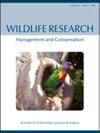引进澳大利亚和新西兰的桑巴鹿的起源和种群遗传学
IF 1.6
3区 生物学
Q3 ECOLOGY
引用次数: 2
摘要
一些引进物种的居群造成了显著的不良影响,但也可以作为遗传多样性的储存库。桑巴鹿(Cervus unicolor)在其本土范围内是“脆弱的”,在澳大利亚和新西兰是入侵的。遗传数据可用于确定这些引进种群是否可作为逐渐减少的本地种群的遗传库,并确定可供管理的空间单元。目的:确定澳大利亚和新西兰桑巴鹿的来源,并确定其遗传多样性和种群结构特征。方法利用24只新西兰鹿和63只澳大利亚鹿的线粒体控制区序列和18个核微卫星位点进行分析。我们通过FST、AMOVA和结构分析来估计遗传多样性和群体分化。我们将我们的数据与先前发表的27个本地和入侵范围序列进行比较,以确定系统发育关系。主要结果:澳大利亚和新西兰的山巴尔鹿在基因上与原居地西部(印度南部和中部高地以及斯里兰卡)的鹿更相似,而与东部(印度东部和整个东南亚)的鹿更相似。核遗传多样性低于原生地;在每个引入种群中只发现一个线粒体单倍型。澳大利亚和新西兰的鹿在遗传上是不同的,但在两个种群中都没有种群结构。结论两个引种群体在中性位点上的遗传差异表明,在功能位点上也可能存在潜在的多样性。我们在引进种群中发现的种群遗传结构的缺乏表明,这些种群中的个体在采样区域内的分散没有遇到障碍。尽管与本地区相比,引进区鹿的遗传多样性有所降低,但澳大利亚和新西兰的鹿具有独特的遗传变异,可用于加强本地区受威胁种群的遗传多样性。在我们取样的地区,明显的高水平基因流动表明,在澳大利亚和新西兰,局部控制不太可能有效。本文章由计算机程序翻译,如有差异,请以英文原文为准。
Origins and population genetics of sambar deer (Cervus unicolor) introduced to Australia and New Zealand
ABSTRACT Context Some populations of introduced species cause significant undesirable impacts but can also act as reservoirs for genetic diversity. Sambar deer (Cervus unicolor) are ‘Vulnerable’ in their native range and invasive in Australia and New Zealand. Genetic data can be used to determine whether these introduced populations might serve as genetic reservoirs for declining native populations and to identify spatial units for management. Aim We aimed to identify the provenance of sambar deer in Australia and New Zealand, and to characterise their genetic diversity and population structure. Methods We used mitochondrial control region sequences and 18 nuclear microsatellite loci of 24 New Zealand and 63 Australian sambar deer collected across continuous habitat in each location. We estimated genetic diversity and population differentiation by using pairwise FST, AMOVA, and structure analyses. We compared our data with 27 previously published native and invasive range sequences to identify phylogenetic relationships. Key results Sambar deer in Australia and New Zealand are genetically more similar to those in the west of the native range (South and Central Highlands of India, and Sri Lanka), than to those in the east (eastern India, and throughout Southeast Asia). Nuclear genetic diversity was lower than in the native range; only one mitochondrial haplotype was found in each introduced population. Australian and New Zealand sambar deer were genetically distinct but there was no population structure within either population. Conclusions The genetic differences we identified between these two introduced populations at putatively neutral loci indicate that there also may be underlying diversity at functional loci. The lack of population genetic structure that we found within introduced populations suggests that individuals within these populations do not experience barriers to dispersal across the areas sampled. Implications Although genetic diversity is reduced in the introduced range compared with the native range, sambar deer in Australia and New Zealand harbour unique genetic variants that could be used to strengthen genetic diversity in populations under threat in the native range. The apparent high levels of gene flow across the areas we sampled suggest that localised control is unlikely to be effective in Australia and New Zealand.
求助全文
通过发布文献求助,成功后即可免费获取论文全文。
去求助
来源期刊

Wildlife Research
生物-动物学
CiteScore
4.30
自引率
15.80%
发文量
56
审稿时长
3 months
期刊介绍:
Wildlife Research represents an international forum for the publication of research and debate on the ecology, management and conservation of wild animals in natural and modified habitats. The journal combines basic research in wildlife ecology with advances in science-based management practice. Subject areas include: applied ecology; conservation biology; ecosystem management; management of over-abundant, pest and invasive species; global change and wildlife management; diseases and their impacts on wildlife populations; human dimensions of management and conservation; assessing management outcomes; and the implications of wildlife research for policy development. Readers can expect a range of papers covering well-structured field studies, manipulative experiments, and analytical and modelling studies. All articles aim to improve the practice of wildlife management and contribute conceptual advances to our knowledge and understanding of wildlife ecology.
Wildlife Research is a vital resource for wildlife scientists, students and managers, applied ecologists, conservation biologists, environmental consultants and NGOs and government policy advisors.
Wildlife Research is published with the endorsement of the Commonwealth Scientific and Industrial Research Organisation (CSIRO) and the Australian Academy of Science.
 求助内容:
求助内容: 应助结果提醒方式:
应助结果提醒方式:


